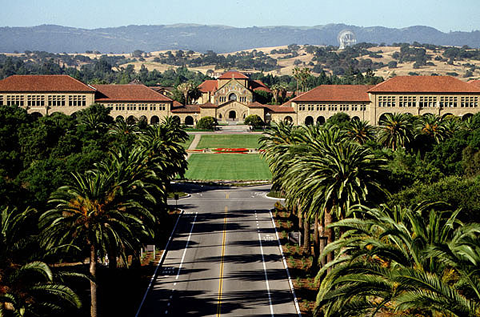|
Date: Saturday, June 2, 2012.
Location: Building 380, basement, room: 380-C.
contact: David Hoffman,
Yanir Rubinstein, Brian White.
The Spring 2012 meeting of the Bay Area Differential Geometry will take place
at Stanford University.
It will feature 2 main talks, and 3 shorter talks
by graduate students.
We hope the graduate student talks
will become a tradition in the last BADG meeting each year.
Schedule:
9:30-10:30 breakfast, refreshments.
10:30-11:30 Yakov Eliashberg
(Stanford)
12:00-12:30 Alessandro Carlotto
(Stanford)
2:30-3 Corey Shanbrom
(Santa Cruz)
3:30-4:30 Fernando Coda-Marques
(IMPA)
5:00-5:30 John Pardon
(Stanford)
6:30 Banquet: at Cafe Sophia
($25; $10 post-docs, $5 students).
If you are interested in
attending the
dinner banquet,
you should register by clicking here:
sign-up for banquet
Abstracts:
Yakov Eliashberg:
Renaissance of h-principle in symplectic topology
From the very first steps of symplectic topology, rigid and flexible results coexisted side by
side. However, beginning from the introduction of the method of holomorphic curves by Gromov,
rigid results dominated the development of symplectic topology. On the other hand, some recent
successes on the flexible side again reminded us that flexible and rigid sides of symplectic
topology are not far from each other.
Alessandro Carlotto:
Updates on the Gauss curvature prescription problem on singular surfaces
The Gauss curvature prescription problem is modeled by a class nonlinear equations (usually
named after Liouville) that exhibit a number of interesting and deep properties. In the last ten
years, their singular counterparts have been extensively studied and the
corresponding variational theory shows a surprising interplay of Analysis and Topology. In this
talk I will try to give a glimpse of such theory and say how it allows to answer hard questions
concerning the motivating geometric problem.
Corey Shanbrom: The Kepler Problem on the Heisenberg Group
The Kepler problem is among the oldest and most fundamental problems in mechanics. It has
been studied in curved geometries, such as the sphere and hyperbolic plane. Here, we
formulate the problem on the Heisenberg group, the simplest sub-Riemannian manifold. Key to
this formulation is a 1973 result of Folland, who found the fundamental solution to the
Heisenberg sub-Laplacian. We will discuss the geometry of this space and present partial
results and first steps towards a solution to the Kepler-Heisenberg problem.
Fernando Coda Marques: Min-max theory and the Willmore conjecture
In 1965, T. J. Willmore conjectured that the integral of the
square of the mean curvature of any torus immersed in Euclidean
three-space is at least 2\pi^2. In this talk we will describe a solution
to the Willmore conjecture based on the min-max theory of minimal surfaces.
This is joint work with Andre Neves (Imperial College, UK).
John Pardon: Totally disconnected groups (not) acting on three-manifolds
Hilbert's Fifth Problem asks whether every topological group which is a manifold is in fact a
(smooth!) Lie group; this was solved in the affirmativ e by Gleason and Montgomery--Zippin. A
stronger conjecture is that a locally compact topological group which acts faithfully on a
manifold must be a Lie group. This is the Hilbert--Smith Conjecture, which in full generality is
still wide open. It is known, however (as a corollary to the work of Gleason and
Montgomery--Zippin) that it suffices to rule out the case of the additive group of p-adic
integers acting faithfully on a manifold. I will present a solution in dimension three. The
proof uses tools from low-dimensional topology, for example incompressible surfaces, minimal
surfaces, and a property of the mapping class group.
|

